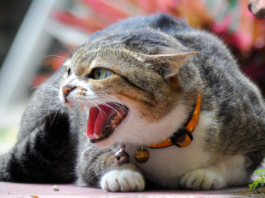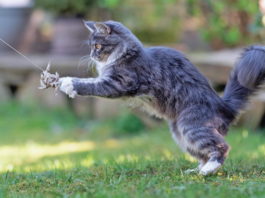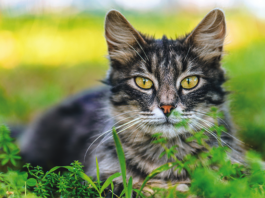When Aggression Has a Physical Basis
Your cat is shy but generally sweet natured and affectionate. Imagine your shock, then, when you reach to pick him up and he tries to bite you — for no apparent reason. Did your cat’s inner tiger emerge? When the onset of feline aggression is sudden, there’s a good chance that the source could be a health problem, and you need to make an appointment with your veterinarian. “A medical cause for aggression in cats is relatively rare, but it must always be ruled out,” says Katherine A. Houpt, VMD, Ph.D., diplomate of the American College of Veterinary Behaviorists and emeritus James Law Professor of Animal Behavior at Cornell University’s College of Veterinary Medicine. “The primary cause of medically based aggression is pain, no matter what the source of that pain.”
Is Your Aging Cat Slowing Down?
At the age of 12, your cat seems to be slowing down a bit, and that could be perfectly normal. After all, a cat of her age — equivalent to the age of 65 or so in a human — has been living a full life and deserves to take it easy on herself. Nevertheless, it’s a good idea to have the animal checked out by your veterinarian. It’s quite possible that her diminished activity is a consequence not only of her advancing age, but of a debilitating pain in one or more of her joints.
Cat Fights: What You Should Know
All kittens play, practicing to defend themselves by arching their backs, jumping on each other, chasing each other and maybe exchanging a few nips on the ears. “The difference between playing and fighting,” says Katherine A. Houpt, VMD, the emeritus James Law Professor of Animal Behavior at Cornell University’s College of Veterinary Medicine, “is that when playing, cats will take turns chasing each other. There isn’t one dominant aggressor or one main victim.” In general, however, cats don’t play much after 16 months of age, and males are more likely to engage in play of this kind. As for fighting, cats will fight at any age. “True fighting is usually more of a one-way process,” says Dr. Houpt. “One cat will be the aggressor and the other will be the victim. Hissing, clawing and batting with the paws are more fear directed than playful. The noisier the interaction, the more likely it’s a fight and not play.”
Does Your Cat Need a Specialist?
Litter box aversion. Aggression. Inappropriate scratching or destructive behavior. Eating or chewing non-food materials. Cat carrier avoidance. Separation anxiety. Other fears and phobias that make you and your cat unhappy. When your cat develops a behavior problem, you may need professional advice. But whom should you call? Your veterinarian should be first on the list to rule out any medical problems. But after your cat’s clean bill of health, your veterinarian may suggest the help of a certified applied animal behaviorist or a board-certified veterinary behaviorist. While either one can help you solve your cat’s adjustment difficulty, there are some differences in the services each provides.
Has Your Cat Become Aggressive?
We all know people that we try to avoid, but what if your cat develops an unpleasant attitude? What if one cat attacks another in your home, or even your dog — or even you? Territoriality and fear are usually the causes. Luckily, both can be controlled with some patience and understanding. Cats don’t plan these unpleasant behaviors to bother you. They aren’t plotting ways to punish you, either. “It’s more likely that your cat is saying, ‘Hey, this is my house,’” explains Katherine Houpt, VMD, PhD, and the emeritus James Law professor of Behavior Medicine at Cornell University’s College of Veterinary Medicine.
How to Curb Destructive Scratching
Just days after youve invested in new furniture, your cat decides she really loves it, too. Its the place shes chosen to give herself a pedicure, and soon the arms of that beautiful new sofa look like theyve gone through a shredder. You may notice your cat flexing her nails when she first gets up and stretches or suddenly stop to sink her nails into the wall-to-wall carpeting as she crosses a room. She may scratch at the end of a burst of energy after playing with her favorite toy. Fabrics, carpet, wood, cardboard there are numerous materials in your house that can soon become a target for your cats clawing.
When Your Cat Dislikes Company
When Safflower, a 12-week-old female kitten, earnestly beckoned from her cage in a Manhattan animal shelter, Deirdre knew she was the one for her. The kitten settled in quickly with Deirdre and her two roommates in a small apartment. Safflower loved everyone; Deirdre was even jealous when Safflower would occasionally sleep on her roommates beds instead of her own. The growing kitten played and romped with visitors, and even greeted people at the door.
The Danger of Cat Bites
Buddy, a streetwise stray cat that had been rescued from a vacant parking lot, took great exception to a male cat spraying the front door of his adoptive home. To even out the turf war, Buddy decided to launch a counter attack - by spraying the inside of the door. "I saw Buddy positioning [to spray], so I tried to scoot him away from the door," explains Nancy Peterson, information specialist for the Humane Society of the United States in Washington, D.C. "He bit me. It wasnt just a little tooth scratch, either. It was a nice bite," she says. As a former veterinary technician, Peterson was quite aware of the health risks that a cat bite poses -even when the cat is up-to-date on its veterinary care and is vaccinated against rabies.
What To Do About Cat Fights
While fighting among cats is not typical behavior, it certainly does happen in the multicat household. Read on to learn some reasons why cats pick fights with each other - and what you can do about it. All kittens play, practicing to defend themselves by arching their backs, jumping on each other, chasing each other and maybe exchanging a few nips on the ears. "The difference between playing and fighting," says Katherine A. Houpt, VMD, emeritus professor of animal behavior at Cornell Universitys College of Veterinary Medicine, "is that when playing, cats take turns chasing each other. There isnt one dominant aggressor or one main victim. Nobody hides."
The Female Cat in Heat
The yowls of a cat in heat are unmistakable. When a female cat needs to mate, you should expect incessant crying, strange posturing and constant attempts to escape outdoors to waiting males. The best thing you can do about your cat in heat is to prevent it from happening in the first place. Its a smart idea to have her neutered before her first heat cycle. However, sometimes thats not possible. So if youve never witnessed a cat in heat, heres what you should expect.
Your Cats Whiskers
The old-fashioned term "the cats whiskers" means the height of perfection or first-rate. Popular in the 1920s, this expression, along with "the cats meow," referred to the daring flappers described as "impossible to shock." While the term is American in origin, people have disagreed over who deserves credit for coining it. Regardless, the phrases meaning shows that the people who first used the expressions certainly understood the unique capabilities of your felines most sensitive hairs. Cat whiskers - also called tactile hairs - are found on your cats eyebrows, chin, cheeks and in an area behind its forelegs above the paw. They are two to three times thicker than other hairs and taper to a fine, flexible tip. Approximately 12 of these stiff bristles align in four rows that protrude from either side of the cats muzzle. The top row moves independently of the middle row.
Does Your Cat Need Help?
Inappropriate urination or defecation. Aggression. Inappropriate scratching or destructive behavior. Eating or chewing non-food materials. Cat carrier avoidance. Separation anxiety. Other fears and phobias. When your cat develops a behavior problem, you may need professional advice. But whom should you call? Your veterinarian should be first on the list. But for particularly difficult problems, he or she may enlist the help of a certified applied animal behaviorist or a board-certified veterinary behaviorist. While either one can help you solve your cats adjustment difficulty, there are some differences in the services each provides.
















